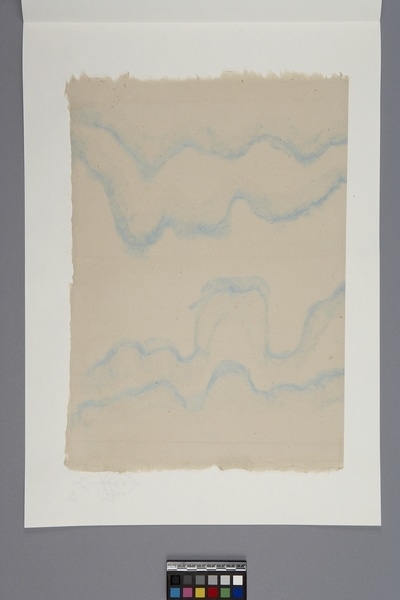Paper Item Number: Ed5.1749 from the MOA: University of British Columbia


Description
Washi sample mounted on white, labelled and folded paper with 3-pointed leaf above scrolled 'M' watermark. Sample is four uneven light blue wavy lines width-wise across light brown paper. Lines are marble-like in appearance. Paper is smooth with dark particles added.
History Of Use
Papermaking originated on the Asian mainland and spread to Japan by 1500 years ago. For centuries Japan has produced the greatest quantity and variety of handmade paper or washi in the world. Traditionally, papermaking was a family or community enterprise which thrived in mountain farming communities where cold, pure water and wild bast fibre shrubs, such as mulberry, are plentiful. Washi is an important cultural symbol and holds a place in nearly every aspect of Japanese life. It is also a significant aspect of both Shinto and Buddhist rites and customs. Uchigumo, classic type of sukimoyogami, is one of the oldest papers, dating to the 11th century. Najio, a form of uchigumo, is mentioned in literature written in 1777 and elsewhere. Used for fusuma sliding doors, calligraphy, and verse writing.
Cultural Context
sample
Narrative
This is part of the Tesukiwashi Taikan, a collection of handmade paper published, in an edition of 1000 copies, in Tokyo as a project to commemorate the centennial of Mainchi Newspapers and to preserve Japanese handmade paper. A collection on this scale had not been made before. This collection consists of 5 boxes of mounted and labelled samples with an explanatory book in 4 of the boxes. The text is in Japanese and with less detail, in English. Compiled and edited by a special editorial staff of scholars. Published by the Mainchi Newspapers of Tokyo, Japan.
Item History
- Made by Takenobu Tanino (Maker) in Hyogo, Japan before 1974
- Collected during 1977
- Owned by Yoshihisa Okamatsu before March 23, 1977
- Received from Yoshihisa Okamatsu (Donor) on March 23, 1977
What
- Name
- Paper
- Identification Number
- Ed5.1749
- Type of Item
- paper
- Overall
- height 51.4 cm, width 36.3 cm
Who
- Culture
- Japanese
- Creator
- Takenobu Tanino (Maker)
- Previous Owner
- Yoshihisa Okamatsu
- Received from
- Yoshihisa Okamatsu (Donor)
Where
- Holding Institution
- MOA: University of British Columbia
- Made in
- Hyogo, Japan
When
- Creation Date
- before 1974
- Collection Date
- during 1977
- Ownership Date
- before March 23, 1977
- Acquisition Date
- on March 23, 1977
Other
- Item Classes
- works on paper
- Condition
- good
- Accession Number
- 0369/0017 e